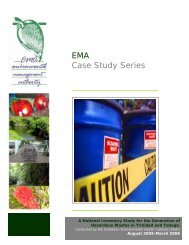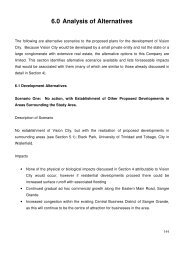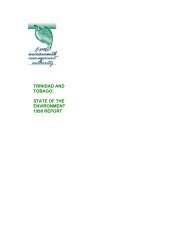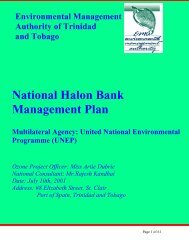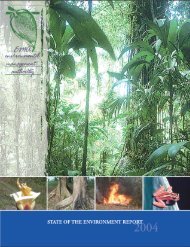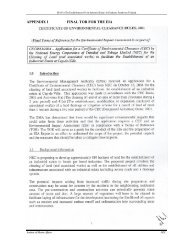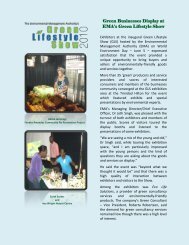Aripo Savannas Strict Nature Reserve - Environmental Management ...
Aripo Savannas Strict Nature Reserve - Environmental Management ...
Aripo Savannas Strict Nature Reserve - Environmental Management ...
Create successful ePaper yourself
Turn your PDF publications into a flip-book with our unique Google optimized e-Paper software.
1.0 EXECUTIVE SUMMARY<br />
This Administrative Record discusses the reasons and issues involved in the proposed action of designating<br />
<strong>Aripo</strong> <strong>Savannas</strong> as an <strong>Environmental</strong>ly Sensitive Area (ESA) under the <strong>Environmental</strong>ly Sensitive Areas Rules,<br />
2001.<br />
The administrative record is designed to demonstrate the process and justification for the selection of <strong>Aripo</strong><br />
<strong>Savannas</strong> as an <strong>Environmental</strong>ly Sensitive Area, and to share this information with the public of Trinidad and<br />
Tobago, while soliciting their input and contributions.<br />
The significance of <strong>Aripo</strong> <strong>Savannas</strong> and its biodiversity has been recognised for many years as part of the<br />
larger Long Stretch Forest <strong>Reserve</strong> declared in 1934, as a proposed Scientific <strong>Reserve</strong> in 1980, and as a<br />
Prohibited Area in 1987.<br />
<strong>Aripo</strong> <strong>Savannas</strong> is the largest remaining natural savannah in the country, fanning out from the foothills of the<br />
Northern Range as old alluvial terraces. These terraces consist of layers of sands, gravels and clays that have<br />
been mined locally for the construction industry.<br />
The <strong>Aripo</strong> <strong>Savannas</strong> has an international reputation for its unusual flora in striking vegetation communities. It is<br />
one of the more intensively studied areas of natural ecosystems in Trinidad. The ten open savannah<br />
communities characterise the ‘savannas’ which have low growing herbaceous vegetation caused by an<br />
impervious hardpan layer a few centimetres below the soil surface.<br />
The complex of habitats making up the <strong>Aripo</strong> <strong>Savannas</strong> <strong>Strict</strong> <strong>Nature</strong> <strong>Reserve</strong> possess characteristics not seen<br />
else where in the country coupled with the high density of rare, threatened and endemic species, the ecosystem<br />
can be considered as unique. Of the 457 species identified so far 38 are restricted to the <strong>Aripo</strong> <strong>Savannas</strong> with<br />
between16 and 20 that are rare or threatened, and 2 endemic floral species.<br />
The <strong>Environmental</strong>ly Sensitive Areas Rules of 2001, seeks to award protection to areas of Trinidad and Tobago<br />
that contain threatened and remarkable representations of this country’s biodiversity. Criteria laid down in the<br />
ESA Rules guide the selection and justification of the areas to be declared. A copy of the ESA Rules 2001 is in<br />
Appendix 1.<br />
The intention of the <strong>Environmental</strong>ly Sensitive Species Rules, 2001, (ESS) is to provide added protection to<br />
certain species. The ESA and ESS Rules are complementary, and intended to support conservation efforts<br />
throughout Trinidad and Tobago.<br />
EMA: The Administrative Record for the Designation of <strong>Aripo</strong> <strong>Savannas</strong> as an <strong>Environmental</strong>ly Sensitive Area



